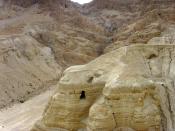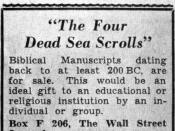Dead Sea Scrolls? What were they hiding?
1991 marks the year the controversy of the famous Dead Sea Scrolls erupted in full force. Since their discovery in 1947, roughly two thousand years have passed since the scrolls were supposedly written and left in the caves. The fact that they are the oldest body of manuscripts relating to the Bible and to the time of Jesus of Nazareth make them a truly remarkable archaeological find. Before their release, there was a tremendous amount of pressure from scholars and media alike to gain "scholarly access." In 1991, The Biblical Archaeology Society published and released photographs of the scrolls able to be viewed via computer images. During the same year, the monopoly on the scrolls publication for over forty years collapsed when the Huntington Library unleashed a torrent of controversy by making the copies of the scroll available to all scholars. For many historians and scholars, the scrolls are an invaluable source for discovering and probing the roots of two of the largest world religions.
For the remaining public, they are precious artifacts shrouded in a sea of mystery and wonder. For many till this day, the theories surrounding the scrolls have been ruminated to the point of exhaustion.
At the outset of the scroll research, a variety of theories have arisen as to who the authors of the scrolls may have been. One of the more popular theories claimed by scholars is that they were written by a secret brotherhood known as the Essenes. Information on the Essenes is inconclusive and without any sound backing. However, the Essenes are believed to be a small ascetic Jewish sect of holy men and women, who held radical views and completely separated themselves from all other religions. (Shapiro). Strangely, they studied all religions in...


